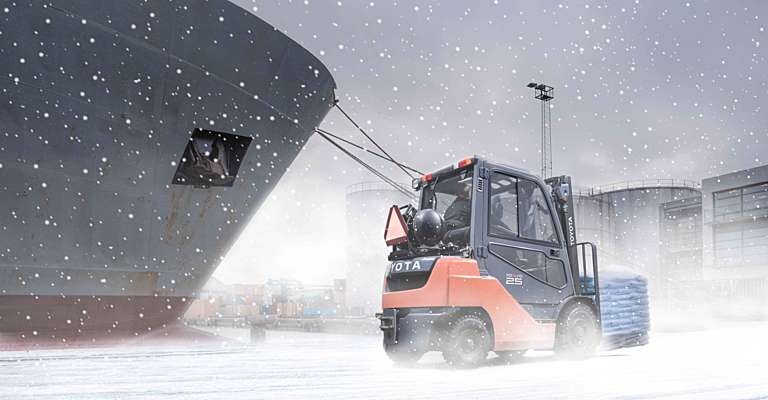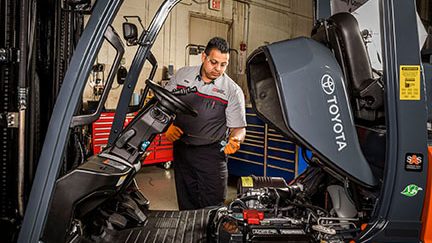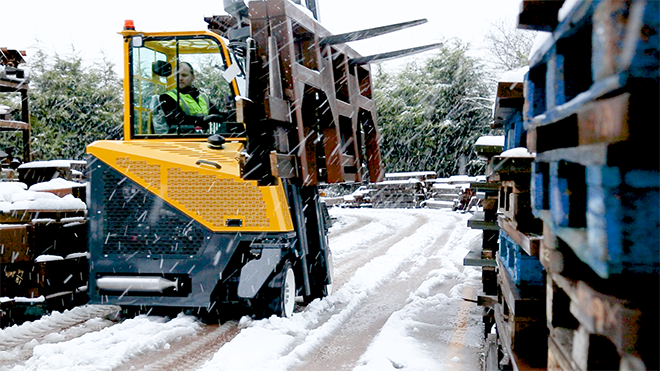
We all know the fall and winter seasons present challenges when running your forklifts outside. Running equipment in rain, snow, or freezing cold creates a plethora of safety challenges for both your operators and their machines. Is your forklift winter ready? Being caught unprepared can lead to large repair costs, costly downtime, and other cold-related problems.
Get ready for the upcoming season now with a pre-season inspection and maintenance plan. Freeze and thaw cycles, combining frigid temperatures and moisture, can adversely affect your equipment. The parts most often impacted are batteries, hydraulics, electrical system, and engines. Your productivity and profitability depend on your equipment being in solid working condition at all times. Consistent and regular inspection of your forklift can detect damage, leaks, and other problems. As temperatures drop, Summit ToyotaLift is here to help you properly winterize your fleet.
Just follow these helpful tips to ensure better productivity and employee safety this winter and a longer lifespan for your forklift.
Warm up your fleet for optimal performance
Diesel-powered engines require longer start-up time in the cold. Before starting any task, always allow several minutes for the forklift to sit idle without any load.
Cold weather is hard on batteries
Cold weather can shorten your battery’s lifespan. Additionally, batteries take longer to charge. For optimal performance, store your batteries inside or in a heated charging station. Test your batteries often and make sure that the cables and terminals are clean and tightly secured. If a new battery is needed, Summit ToyotaLift offers a large selection of high-quality batteries and accessories for all makes and models.
Change the oil and filters as recommended or sooner
Colder temperatures here in the Northeast may cause ice, gelling, or clouding in non-winterized fluids and lubricants. To minimize these issues, change to a winter-weight oil. Have a technician check the forklift’s fuel, air, hydraulic, and transmission filters often. It’s always a good idea to keep the fluids and filters you need on hand so that you can make repairs quickly and easily.

Maintain proper tire tread depth and tire pressure
During the winter, tire pressure should be checked regularly. Remember, every 10oF drop in outside temperature can reduce your tire PSI by up to 2 points. Maintaining the recommended tire pressure ensures the safety of that forklift. The tread on your tires has to be deep enough to get through the snow, consider switching to special tires made for snow or using tire chains. Industrial Tire Service has mobile trucks to swap out tires at your location.
Clean, flush, and replace the antifreeze
We recommend that before winter arrives you clean and flush out your forklift’s cooling system. Then, add new antifreeze. Proper antifreeze levels prevent the engine from freezing during winter months and keep the engine cool in warm weather. Check coolant levels and flow rate after the forklift has been off and is sufficiently cooled.
Check your brakes
Inspecting your brake system is a must-do throughout the year, but especially in the winter months. With harsh weather conditions, reliable braking can help prevent harm and injury.
Make sure all lights are working properly
Check the warning lights, work lights, head and tail lights to ensure they are working correctly. They need to be clean and functional due to low visibility during the winter months.
Keep your operators dry and out of the elements
We recommend that all outdoor forklifts have an all-weather cab enclosure installed. This is important for protecting your employees from the harsh winter elements, especially the cold and wind, which can quickly cause hypothermia. If your lifts work outside for any extended amount of time, we also suggest that you consider a forklift heater. These units are available in a variety of mounting options, including dash mounting, rear mounting, or top, bottom, and side mounting. Summit can recommend and install the heater that best suits your need. Of course, if your equipment already has a cab, please inspect the molding on the doors to check for leaks and cracks.

Don’t put off getting your equipment winter-ready until it’s too late. As you go through your winter preparations checklist, Summit ToyotaLift is here to help keep your equipment running efficiently and your employees safe.
Main Image Source: Toyota Material Handling Europe
